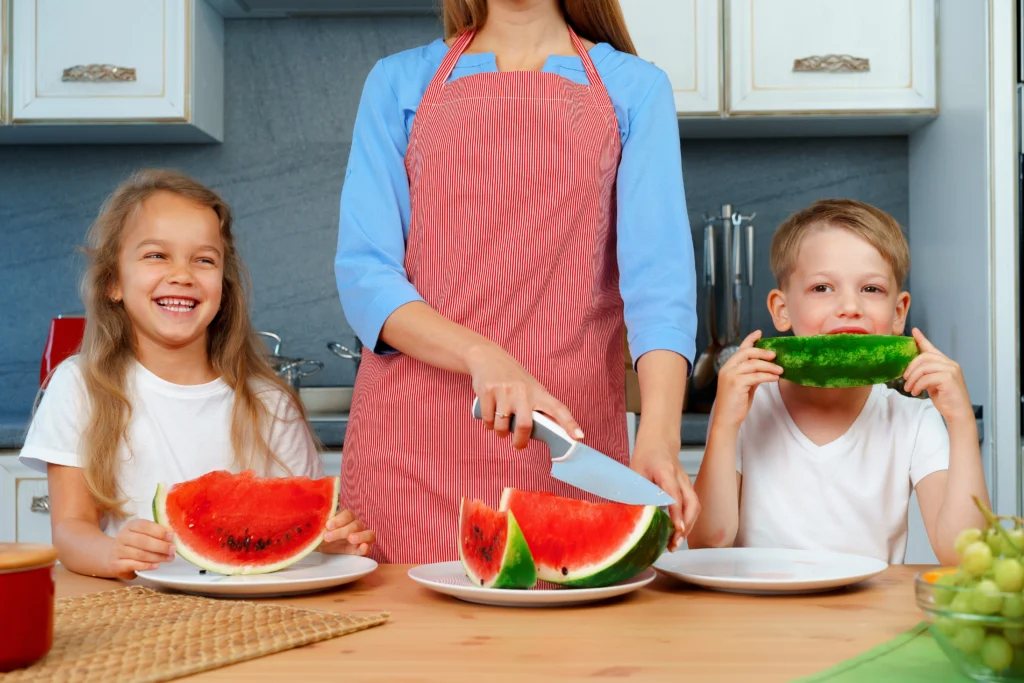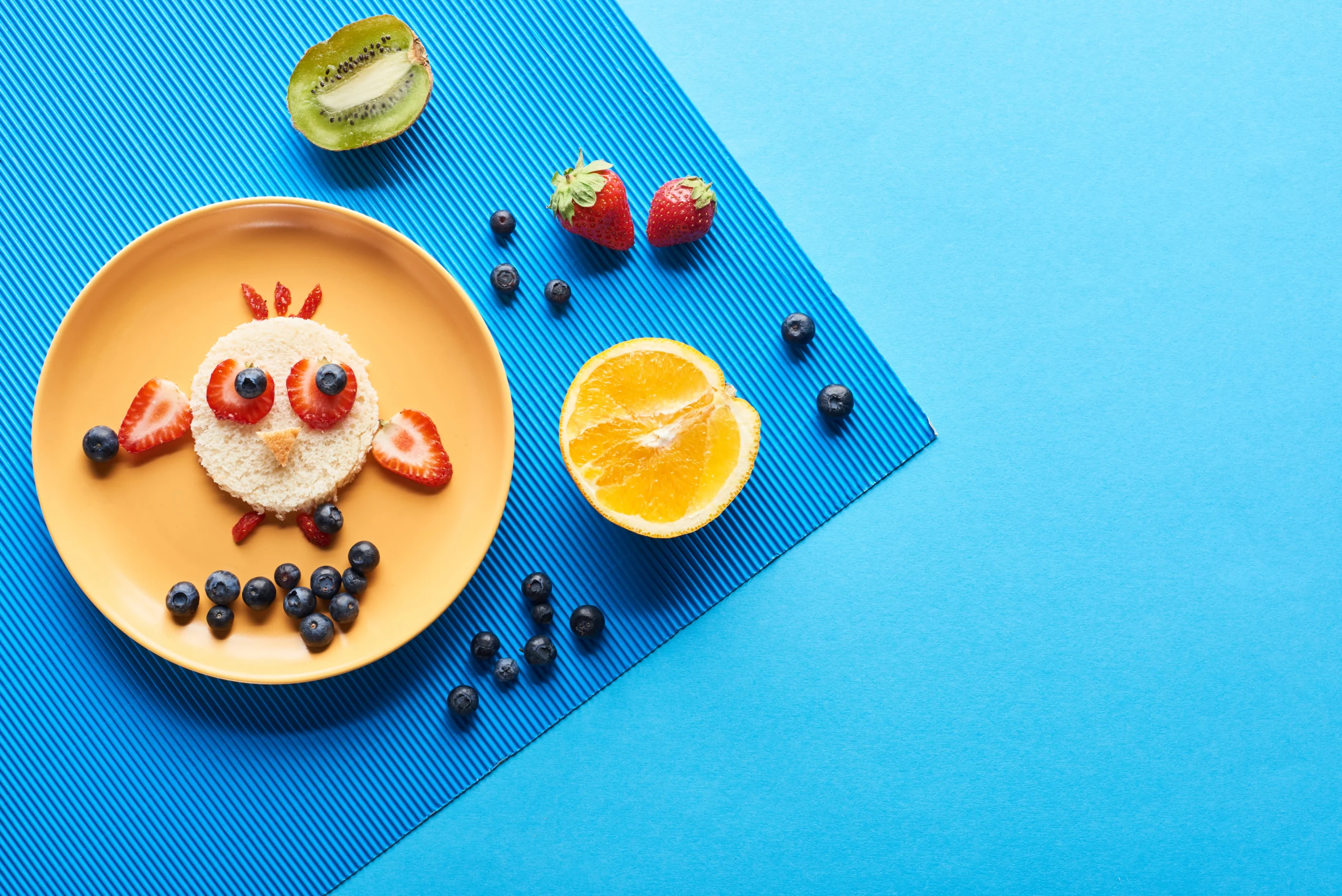Encouraging kids to eat healthy can be a challenge, but it doesn’t have to be boring. Here are 10 tips to make healthy eating fun and enjoyable for your little ones.
Table of Contents
1. Get Creative with Colors
Bright colors attract kids’ attention. Create colorful plates with fruits and vegetables. For example, a rainbow salad with cherry tomatoes, yellow bell peppers, green cucumbers, purple cabbage, and orange carrots can make lunchtime exciting. Engage your children by letting them pick their favorite colors and create healthy dishes together.
2. Make Healthy Snacks Easily Accessible
When kids are hungry and snacks are within reach, they are more likely to choose healthier options. Keep bowls of fresh fruits, veggie sticks, and whole-grain crackers on the counter. You could even create a “snack station” in the kitchen. Keeping healthy snacks visible encourages kids to munch on them throughout the day.
3. Involve Kids in Meal Preparation
When kids help in the kitchen, they’re more likely to enjoy the meals. Let them measure ingredients, mix things up, or assemble their own sandwiches. This hands-on approach teaches them about healthy eating while making it a fun family activity.
4. Use Fun Shapes and Sizes
Transform ordinary meals into fun creations! Use cookie cutters to shape fruits, vegetables, or sandwiches into stars, hearts, or their favorite cartoon characters. You can also serve food on colorful plates that grab their attention, making mealtime feel like a special event.
5. Create a Family Challenge
Turn healthy eating into a game by hosting a family challenge. Set goals, such as trying a new fruit or vegetable each week, and reward everyone with stickers or small prizes. This encourages kids to explore unfamiliar foods in a fun way.
6. Offer Choices
Letting kids make their own choices empowers them and encourages healthy eating. Instead of saying, “You should eat broccoli,” offer options like, “Would you prefer broccoli or carrots with dinner?” This way, they feel involved in their own eating habits.
7. Educate with Fun Facts
Teach children about nutrition in a fun way. Share interesting facts about veggies and fruits. For instance, did you know that carrots help you see better at night? Making it a game to learn about food’s benefits can spark kids’ interest in nutritious choices.
8. Model Healthy Eating Habits
Children often imitate adults. Show them that you enjoy healthy foods by eating them yourself. Share your favorites openly, and explain why they’re good for your body. When they see you enjoying healthy meals, they’ll want to join you!
9. Make Mealtime a Family Affair
Sit down together as a family during mealtime whenever possible. It’s a great opportunity to bond and discuss the day. Talk about what everyone is eating and encourage kids to share their favorite healthy foods. The social aspect of eating together will make meals more enjoyable.
10. Reward Healthy Choices
Positive reinforcement works wonders! Celebrate when your child makes healthy food choices. Acknowledge their efforts by giving them praise or small rewards. This creates a positive atmosphere around healthy eating and encourages them to continue making smart choices.
By implementing these tips, you can make healthy eating a fun and engaging experience for your kids. Remember, the goal is to create a positive relationship with food, making nutrition a part of their lifestyle that they enjoy. With your support, they can grow up to be healthy and happy eaters!

The Importance of Involving Kids in Meal Planning
Meal planning is not just about grocery lists and healthy recipes; it’s an opportunity for you to bond with your kids while teaching them valuable life skills. When you involve your children in meal planning, you give them a voice in choosing their food, which greatly enhances their interest in healthy eating. Here are several compelling reasons why you should engage your kids in the meal planning process.
Encourages Healthy Choices
When kids participate in deciding what goes on their plates, they are more likely to choose healthier options. By discussing different food groups, nutrients, and the benefits of various foods, you instill in them the importance of balanced meals. They learn to appreciate fruits, vegetables, and whole grains, making it more likely for them to pick these options at mealtime.
Fosters a Sense of Responsibility
Meal planning helps impart responsibility and decision-making skills. When children are given the task of choosing meals for the week, they learn to consider factors like nutritional value, preparation time, and family preferences. This not only nurtures responsibility but also boosts their confidence, knowing they played a part in the family’s dietary choices.
Strengthens Family Bonds
Food is a central part of family life. Involving your kids in meal planning can bring the family closer together. You can share stories while cooking or at the dinner table, creating a warm environment where communication thrives. Engaging them in discussions about food preferences and cooking techniques fosters connection and understanding within the family.
Enhances Cooking Skills
As kids help you with meal planning, they also gain valuable cooking skills. Simple tasks like washing vegetables, stirring mixtures, or measuring ingredients can teach them the basics of cooking. These hands-on experiences build their confidence in the kitchen, preparing them for future independence. They will be much more likely to experiment with cooking as they grow.
Promotes Creativity
Involving kids in meal planning allows them to express their creativity. Encourage them to suggest and choose recipes they’d like to try or to invent their dishes. This creativity makes meals fun and educational as they learn the balance of flavors and textures. Letting them decorate cupcakes or arrange a colorful fruit platter cultivates an appreciation for food presentation, too.
Teaches Budgeting Skills
When kids are involved in meal planning, you can teach them about budgeting and smart shopping. Show them how to compare prices, select seasonal ingredients, and plan meals that fit within your budget. Understanding how to shop wisely not only helps them when they grow older but also reinforces the value of money.
Builds Understanding of Food Sources
Take this opportunity to educate your children about where their food comes from. Discuss the difference between fresh, frozen, and canned foods, and talk about local versus imported produce. You can even take a trip to a farmer’s market or a grocery store to explain how different food items are grown, processed, and delivered. This awareness fosters respect for food and encourages them to make conscious choices.
- Involve Kids in Grocery Shopping: Make grocery trips educational by explaining the importance of selecting fresh produce and wholesome ingredients.
- Plan a Weekly Menu: Sit down together to create a menu for the week. Encourage them to list meals they want to try, ensuring a variety of dishes.
- Assign Roles: Give kids specific roles during meal preparation. They can set the table, wash vegetables, or assist with cooking safely.
- Introduce New Foods: Challenge them to try one new food each week, expanding their palate and reducing pickiness over time.
Involving kids in meal planning is a powerful tool for nurturing a positive relationship with food. It empowers them to make informed choices, feel valued, and develop lifelong skills. Engage your children in this enriching experience, and enjoy the delicious results together!

Creative Ways to Sneak Vegetables into Your Child’s Diet
Many parents face the common challenge of getting their kids to eat enough vegetables. If you’re seeking creative ideas to sneak more greens into your child’s diet, you’re in the right place. Here are some fun and clever techniques that can help you introduce vegetables without your little ones even noticing!
1. Smoothie Surprises
Blend vegetables like spinach, kale, or carrots into tasty smoothies. By combining them with fruits such as bananas, berries, or mangoes, the strong flavors of the veggies get masked, making it a delicious treat children will enjoy.
2. Pasta Perfection
Do your kids love pasta? You can easily sneak in pureed vegetables (like zucchini or butternut squash) into the pasta sauce. This adds a creamy texture and makes it nutritious without changing the taste significantly.
3. Clever Cupcakes
Substitute ingredients in your favorite dessert recipes. For example, you can add grated carrots or zucchini into muffins and cupcakes. They not only stay moist but also add a healthy twist to a beloved dessert!
4. Hidden Veggie Pizza
When making pizza at home, mix finely chopped vegetables like bell peppers, mushrooms, or spinach into the sauce or sprinkle them under the cheese. Kids will love the cheesy goodness and won’t even realize they’re eating their veggies!
5. Fun Shapes and Colors
Use cookie cutters to create fun shapes out of vegetables. Kids are often more excited to eat food that looks fun and appealing! Try making star-shaped cucumbers or dinosaur-shaped carrots. You can also create colorful veggie skewers that are visually attractive.
6. Dip It Good
Introduce a variety of dips that make eating vegetables more enticing. Pair sliced bell peppers, carrots, and cucumbers with hummus, yogurt-based ranch, or guacamole. The tastiness of the dip can often prompt them to munch on the vegetables!
7. Soups and Stews
Soups and stews are perfect for hiding nutritional goodness. Puree different vegetables and incorporate them into your soups. Creamy tomato soup made with added pureed carrots or extra nutritional-packed minestrone can work wonders!
8. Cottage Cheese & Veggies
Provide a fun snack option by serving cottage cheese alongside finely diced veggies. Not only does this combo offer protein, but the cottage cheese can help mask the taste of the vegetables and make them more palatable.
9. Make a Garden Salad Fun
Assemble salads with interesting ingredients like nuts, seeds, or fruit chunks. Encourage your kids to help with the preparation—they may be more inclined to try the vegetables if they participated in the creation!
10. Baking with Veggies
Try incorporating vegetables into pancakes or waffles! Adding pureed sweet potatoes or carrots can give breakfast a healthy twist. The sweetness from these vegetables can make for a delightful dish that your kids will want to eat.
Getting children to eat their vegetables doesn’t have to be a daily battle. With these creative approaches, you can sneak in the nutrition without causing a fuss. Remember, patience and consistency are key! You may be surprised at how quickly your children adapt to and even enjoy their new, healthier meals.

Understanding Food Labels: Teaching Kids to Make Healthier Choices
Teaching kids to understand food labels is an essential step in helping them make healthier choices. Food labels provide valuable information about what we eat, and when children know how to read and interpret them, they become empowered to make informed dietary decisions. Here’s how to help them navigate food labels effectively.
Start with the Basics
Begin by explaining the different components of a food label. Focus on key elements like:
- Serving Size: This tells you how much of the food is typically consumed in one sitting. It’s crucial because the nutritional information is based on this amount.
- Calories: Explain that calories measure the energy the food provides. Highlight the importance of balancing calorie intake with physical activity.
- Nutrients: Discuss the significance of carbohydrates, proteins, fats, vitamins, and minerals. Emphasize that whole foods usually provide better nutrition compared to processed items.
Read the Ingredients List
The ingredients list is a treasure trove of information. Teach your kids to look for the following:
- Whole Foods: Ingredients that are natural and recognizable are usually better choices. Encourage them to choose products where whole foods are listed at the top.
- Avoiding Additives: Explain that some ingredients like high fructose corn syrup, artificial colors, or preservatives might not be the healthiest options.
- Allergen Warnings: Teach them to identify common allergens such as nuts, dairy, and gluten, which is essential for those who may have sensitivities.
Focus on Nutritional Values
Help your children understand the nutritional values on food labels. Use the following strategies:
- Daily Values: Clarify that these percentages show how much a nutrient in a serving contributes to a daily diet. Recommend that they aim for foods with higher percentages of nutrients like fiber, vitamins, and minerals.
- Low vs. High: Explain what constitutes low and high amounts of fats, sugars, and sodium. A food is typically considered low if it contains 5% or less of the daily value and high if it has 20% or more.
- Make Comparisons: Encourage them to compare similar products. For example, if choosing a breakfast cereal, guide them to look at the fiber content or sugar levels side by side.
Encourage Healthy Snacking
Teach your kids that snacking can be healthy, too. When looking at snack labels, suggest they aim for:
- Fruits and Vegetables: Focus on fresh produce with little to no additives.
- Nuts and Seeds: These are often packed with nutrients and healthy fats, but moderation is key due to their calorie density.
- Whole Grains: Encourage choosing whole-grain snacks that are high in fiber to aid digestion and keep them feeling full longer.
Make It a Fun Activity
Make label reading an enjoyable experience. You can turn it into a game by:
- Label Reading Races: See who can find the healthiest snack in a store or at home the fastest.
- Creating a Healthy Snack List: Together, compile a list of nutritious products based on label findings to take with you while shopping.
- Cooking Together: Use recipes that require checking labels for ingredients. This reinforces the information they learn in a practical way.
Lead by Example
Your behavior sets a powerful example. Kids are more likely to embrace healthy eating habits if they see you reading food labels and making nutritious choices. Share your thoughts about what makes a food healthy or not, and engage them in discussions about your choices.
Teaching kids about food labels equips them with knowledge for a lifetime. By empowering them to understand nutritional information, ingredients, and healthy choices, we help build a foundation for a healthier future. This proactive approach creates informed eaters who can navigate food options confidently and make choices that support their well-being.

The Role of Parents in Promoting Healthy Eating Habits
As a parent, your influence on your child’s eating habits is profound. You play a crucial role in shaping their food preferences and attitudes toward healthy eating. Here are some effective strategies to promote healthy eating habits in your family.
Lead by Example
Your behavior sets a foundation for your child. If you regularly choose fruits, vegetables, and whole grains, your child is more likely to follow suit. Make healthy food choices visible and accessible at home. Snack on carrot sticks instead of chips, and choose water over sugary drinks. When eating together, showcase your enthusiasm for nutritious foods.
Involve Kids in Meal Planning
Allowing your kids to participate in meal planning fosters their interest in healthy eating. Include them in creating a weekly menu, and encourage them to choose healthy recipes. Take a trip to the grocery store together, letting them pick produce. This not only teaches them about nutrition but also helps them feel more connected to their food.
Make Cooking a Family Activity
Cooking together is a fun and educational way to develop healthier habits. Teach your children how to prepare simple dishes. It can be as easy as slicing fruits for a smoothie or mixing veggies for a stir-fry. Kids who are involved in cooking tend to be more adventurous eaters and are likely to try new foods.
Create a Positive Eating Environment
The dining experience should be enjoyable and stress-free. Aim to have meals at the table without distractions from TV or smartphones. Encourage conversations about the day or interesting topics related to food, such as where it comes from or its benefits. A friendly atmosphere helps children feel comfortable exploring different foods.
Educate About Nutrition
Help your child understand why healthy eating is important. Discuss the benefits of different food groups, healthful nutrients, and how they provide energy for daily activities. You can turn this learning into interactive games or fun quizzes to make it more engaging.
Modify Portions and Choices
Teach your children about portion sizes and making balanced food choices. Provide smaller servings at first; they can always ask for more if they’re still hungry. Introduce the concept of balance by serving a mix of foods on their plates. Aim for a colorful mix of fruits, veggies, protein, and grains to create visual appeal.
Make Healthy Snacks Available
Having nutritious snacks on hand is essential for healthy eating. Instead of chips, stock up on fresh fruits, yogurt, nuts, and whole-grain crackers. Prepare snack packs ahead of time. This not only ensures they grab something healthy but also teaches them how to make good choices independently.
Set Regular Meal Times
Routine fosters better eating habits. Establish regular meal and snack times. When children know what to expect, they are less likely to snack on unhealthy options. Routine teaches them about recognizing hunger cues and feeling satisfied after a meal.
Encourage Hydration
Teach your children the importance of hydration by encouraging water intake. Set a challenge to drink a certain number of glasses of water daily. You can make infused water with fruits for a fun twist. This not only keeps them hydrated but encourages them to make healthier drink choices.
Be Patient and Consistent
Changing eating habits won’t happen overnight. It’s okay if your child is reluctant to try new foods at first. Encourage them to taste rather than forcing them to eat. Consistently offering healthy options will eventually normalize them. Celebrate small victories, and never label foods as “good” or “bad”—this can create unhealthy relationships with food.
Ultimately, your role as a parent is pivotal in guiding your children toward a lifetime of healthy eating habits. By setting a strong example, involving them in the process, and creating a supportive environment, you’ll empower them to make nutritious choices now and in the future.
Conclusion
When it comes to fostering healthy eating habits in kids, the journey can be both enjoyable and rewarding. Embracing strategies like making nutrition fun allows children to view food as an adventure rather than a chore. Involving them in meal planning not only empowers them but instills a sense of responsibility towards their food choices.
Sneaking vegetables into meals creatively can turn the challenge of getting kids to eat their greens into a game, making healthy foods more appealing. Teaching children to understand food labels equips them with the knowledge to make better choices, promoting independence in their eating habits.
Parents play a crucial role in this journey. By setting a positive example, providing diverse healthy options, and engaging in conversations about nutrition, they can significantly influence their children’s relationship with food. The goal is to create an environment where healthy eating is the norm, not the exception.
As you incorporate these tips into your family’s routine, remember that patience and consistency are key. Celebrate small victories and keep the atmosphere light and enjoyable. Building a foundation of healthy eating habits today can lead to a lifetime of positive choices for your children. With your guidance, they can learn to embrace nutritious foods and develop a healthy lifestyle that benefits them as they grow.






